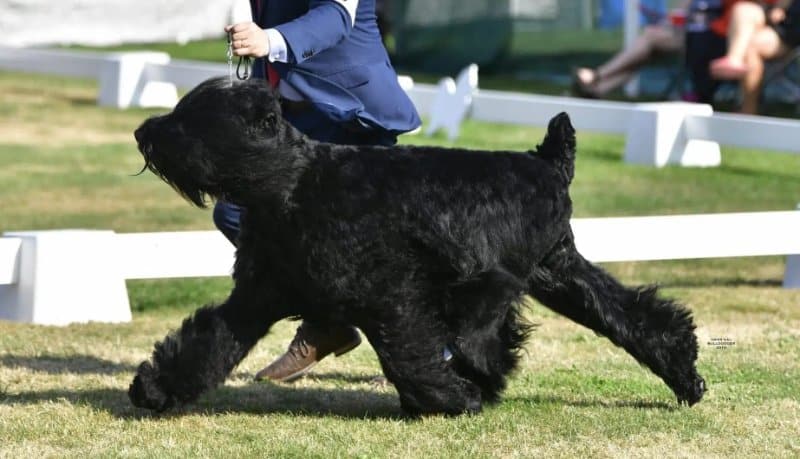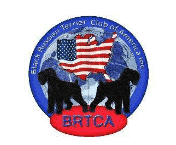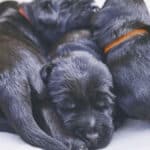Judges have the most visible ability to influence the developmental direction of a breed, especially a new breed, as a result of their ring selections. It is, therefore, of utmost importance that judges have a solid understanding of the standard of the breed and be able to apply the standard to the specimens presented in selecting the best representatives and future producers.
The standard for the Black Russian was substantially revised in 2009, collaborating with representatives of the Russian Kennel Club in an effort to produce a standard as closely as possible to that used by the Russian Kennel Club, who was also going through its own standard revision. With so many Black Russian Terriers being imported to the United States, it was very important that the breed worldwide be as consistent as possible.
Size and substance are major elements to be considered together in judging the Black Russian Terrier. Size and substance are key components in the silhouette that identifies a Black Russian Terrier.
The Black Russian Terrier Breed Standard states:
Size, Proportion, Substance
The height for males at maturity (over 18 months of age) is between 27″ and 30″ with the desired height being between 27″ and 29″. The height for females at maturity (over 18 months of age) is between 26″ and 29″ with the desired height being between 26″ and 28″. Any height deviation is a serious fault. Height consideration should not outweigh that of type, proportion, movement, and other functional attributes. General balance is more important than absolute size.
Size without substance should not be rewarded. Substance without proper proportion and balance should not be rewarded. All things being equal, the dog with the desired height and substance is preferred and should be rewarded. Serious faults must be applied, and include light bone, lack of substance, poor musculature, mature male under 27″ or over 30″, mature female under 26″ or over 29″, light colored eyes, one missing tooth, shyness or excessive excitability.
I have frequently observed that judges do not have a sense of height, especially when faced with an entry of varying heights and varying degrees of substance and coat. Judges are not alone—exhibitors have the same problem. It is very important that judges develop an eye for determining height—be it is a mark on clothing, where fingertips reach, top of the ring table, etc.—so as to avoid potential optical illusions of height.
Height is measured from the top of the withers, not from the top of the coat on top of the withers (which can add an additional inch). Thickness of coat contributes to the illusion of being oversized or hides an undersized frame or fills an undeveloped chest. It is therefore important that the judge is able to determine what lies beneath the coat, both by feel and visually.
Once height has been determined, evaluate for substance and musculature, and finally for balance. All components must be present in the Black Russian Terrier to move harmoniously: correct height, substance, musculature and balance.
The Black Russian Terrier is a working breed, developed as a multi-purpose military dog by the Russian Red Star Kennel in Moscow.
While the majority of the dogs being shown have been conditioned and schooled in proper ring etiquette, remember this breed’s function of guarding and protection, and judges should respect the fact that much of the breed retains this working protective quality. Sufficient spacing should be maintained between dogs while gaiting in a group and handlers should be cautioned against running up on an opponent or otherwise encouraging his dog to jump, spin and “play” in the ring. This is not only distracting, but can be antagonizing to other exhibits when the other dog’s space is invaded.
Physical examination of the dog should be performed in a confident, thorough yet expeditious manner. A judge should approach from the front towards the dog in a purposeful and confident manner. The majority of experienced handlers prefer to show the bite and to lift the fall for the examination of the eyes for the judge. Do check for a scissors bite and for missing teeth (severe fault to DQ).
The Black Russian is an aloof breed. Don’t stare into his eyes. Care should be taken to not bend over the dog, but be efficient and thorough in feeling the framework and musculature of the dog under the coat. A heavy coat and experienced groomer can present a beautiful picture in stack while hiding a multitude of structural faults.
Substance should be confirmed by feeling the circumstance of leg bones, base of tail (a thin tail equals a dog lacking in substance) and breadth of chest. Feel for key points: head size, head length and neck length being approximately equal, width of chest between the front legs, prosternum, shoulder placement and angle, depth of chest, length of back and loin, width and angle of croup and tail set, thigh muscle mass, bend of stifle and hocks. The coat should be trimmed so that the dog’s outline is clearly defined.
Check the coat quality and texture during examination of the body. As the guard hair is often scissored off in grooming, check for coat texture by feeling the leg furnishings. Grooming should not be given more weight than structure, movement and balance in evaluating the dog. Again, it is necessary that the judge determine what is or is not present under the Black Russian Terrier’s coat.
Look for balance and agility in movement. Proper front and rear angulation coupled with correct body proportion will result in a harmonious and effortless gait. Remember in observing the dog in movement that he must be large and strong yet agile. Movement is best observed in a moderate gait.
Know and feel comfortable with the Black Russian Terrier and its standard. Don’t fault judge. Judge the overall dog, prioritizing important features.
Reward the dog that possesses the appearance of a “robust, large, balanced, agile and powerful dog” with “large bone and well-developed muscles” exhibiting “great strength and endurance” and “a stable and reliable temperament, possessing self-assurance and courage.”
Withhold rewards for those specimens which do not.
Black Russian Terriers: Judging Size, Proportion, & Substance – From the March 2020 Issue of Showsight Magazine. Click to subscribe.
Article courtesy of: Susan Sholar, Judges Education Coordinator and Delegate for the Black Russian Terrier Club of America, at [email protected].
Black Russian Terrier Dog Breed Magazine
Showsight Magazine is the only publication to offer dedicated Digital Breed Magazines for ALL recognized AKC Breeds.
Read and learn more about the intelligent Black Russian Terrier dog breed with articles and information in our Black Russian Terrier Dog Breed Magazine.
Error embedding FlippingBook shortcode, please check the flipbook url. (https://digital.showsightmagazine.com/view/449844/)









